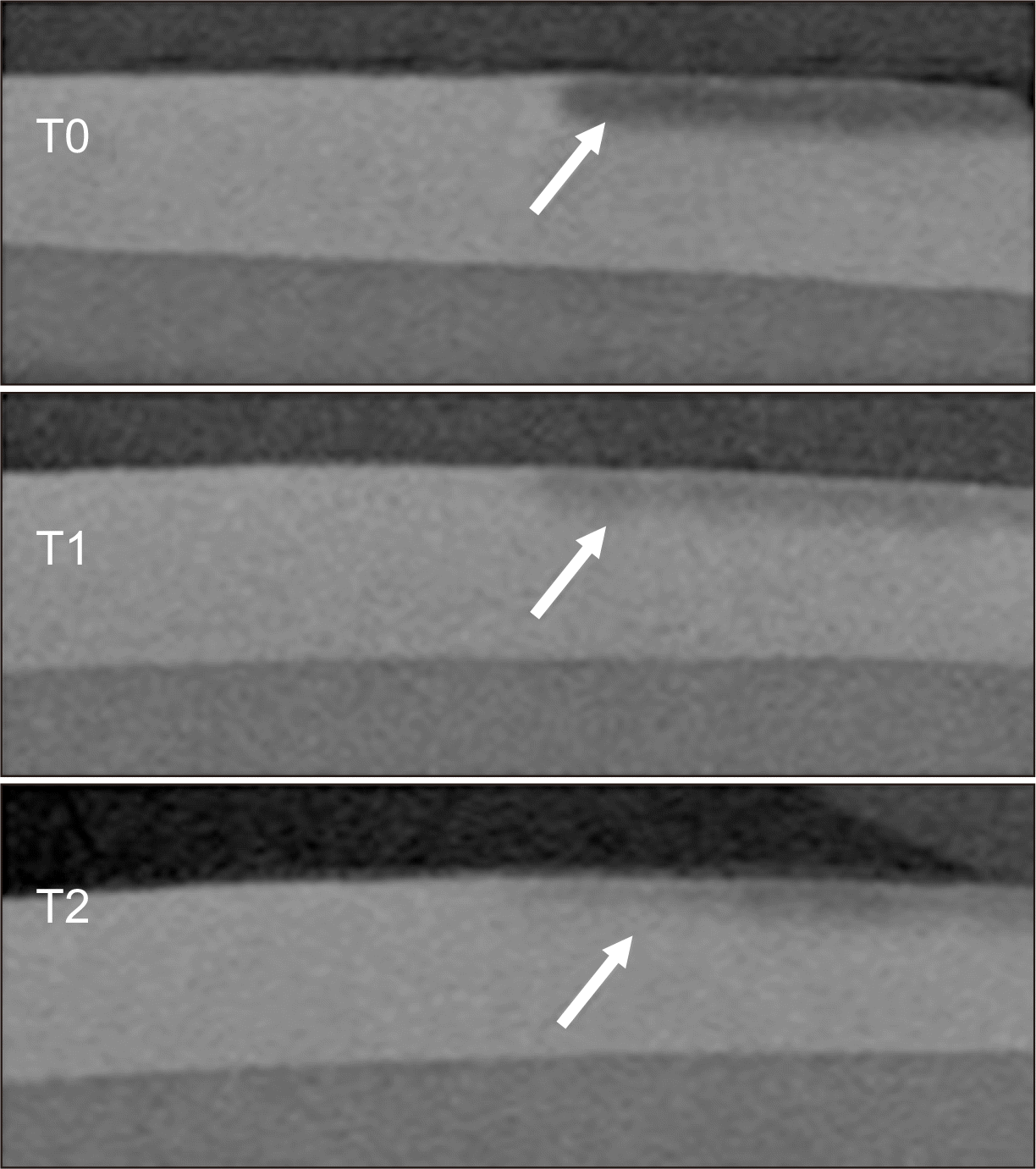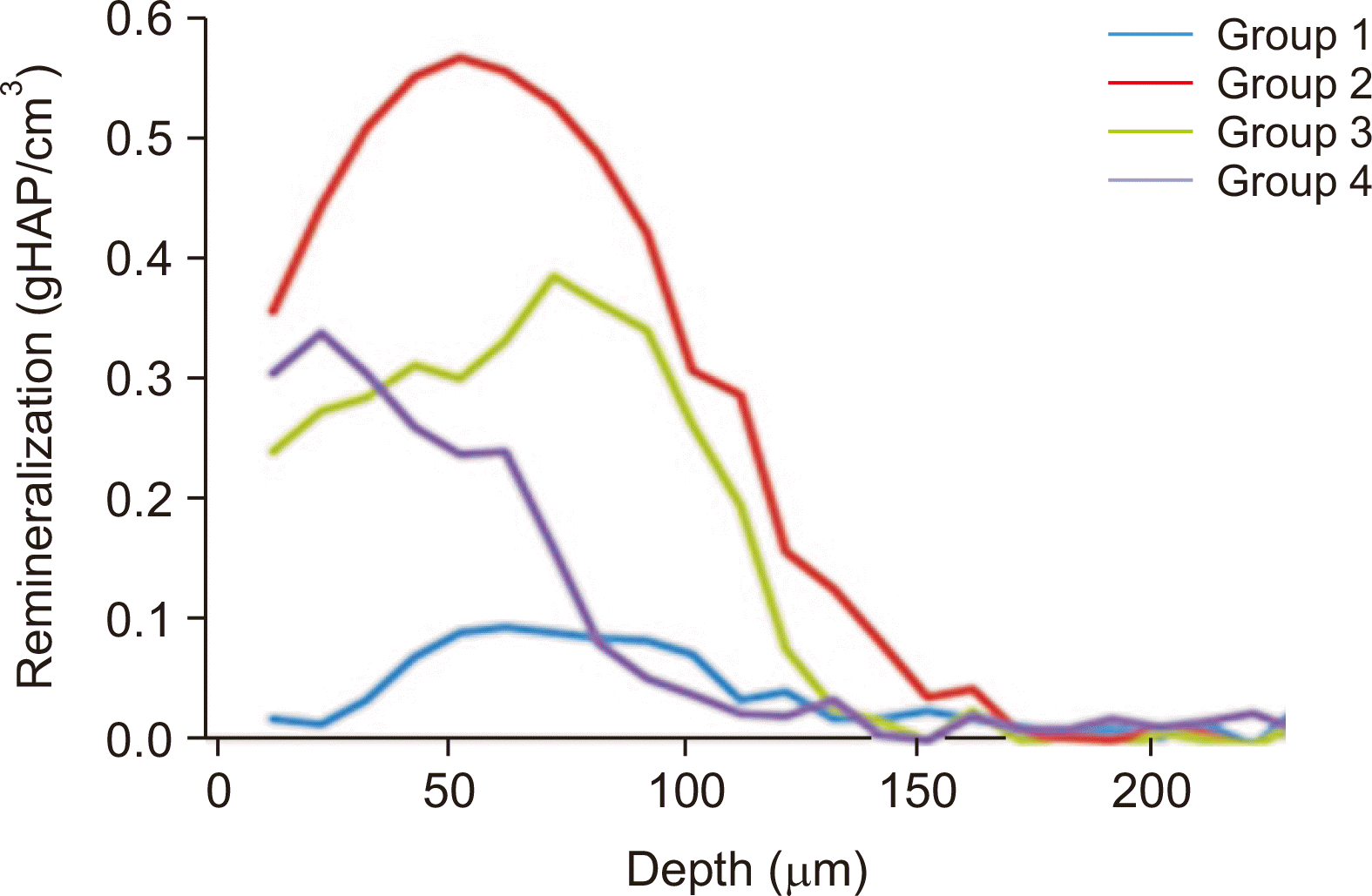This article has been
cited by other articles in ScienceCentral.
Abstract
Objective
To investigate remineralizing effect of three fluoride regimens on artificially demineralized enamel around orthodontic bracket by analyzing mineral density (MD) acquired from micro-computed tomography (micro-CT).
Methods
Forty-eight bracket bonded bovine incisors were prepared to create demineralized enamel (DE) surface. The samples were divided into four groups according to the fluoride regimen 1) no fluoridation, 2) 1.23% acidulated phosphate fluoride (APF) gel, 3) fluoridated toothpaste, and 4) 0.05% sodium fluoride mouthwash. Micro-CT was scanned after demineralization (T0), and 2 weeks (T1) and 4 weeks (T2) of fluoridation.
Results
APF gel showed highest remineralization of DE during T1–T0 interval among the groups (p < 0.05); followed by toothpaste, mouthwash and no fluoridation. APF gel and toothpaste demonstrated significant increase in MD after 4 weeks of application (p < 0.05).
Conclusions
Remineralization effects of three fluoride regimens were depicted through micro-CT analysis, of which APF gel was most effective.
Go to :

Keywords: Cariology, Fluoride, Micro-computed tomography
INTRODUCTION
Fixed orthodontic appliances are a well-known cause for the increased incidence of white spot lesions (WSLs), which result from subsurface enamel demineralization.
1,2 Despite numerous efforts to prevent the formation of WSLs, one study showed that up to 97% patients treated with fixed appliances developed WSLs of varying degrees after therapy.
3 Interventions such as the application of casein phosphopeptide amorphous calcium phosphate (CPP-ACP) complexes, resin infiltration, and microabrasion have shown to be effective in alleviating incipient carious lesions; however, the gold standard treatment for WSLs remains to be established.
4-7
Although multiple studies have reported that topical fluoride is an effective cariostatic agent with the ability to induce remineralization of initial carious lesions,
8-10 studies analyzing the remineralization effect of different fluoride regimens on WSLs by comparing the changes in the mineral density (MD) are scarce. Therefore, this
in vitro study aimed to investigate the remineralization effects of three topical fluoride regimens on artificially induced WSLs around orthodontic brackets bonded to bovine teeth using micro-computed tomography (micro-CT).
Go to :

MATERIALS AND METHODS
Sample preparation
Forty-eight bovine incisors with sound enamel (SE) surfaces were selected. A maxillary first incisor bracket (0.018-inch slot standard, Archist; Daeseung, Seoul, Korea) was bonded to the enamel surface using Transbond XT (3M Unitek, Monrovia, CA, USA). The surface was divided along the line of the bracket slot into demineralized enamel (DE), which was subjected to artificial demineralization, and SE, which was covered with acid-resistant nail varnish.
The demineralizing solution was prepared with distilled water and 1.0 M lactic acid, calcium phosphate tribasic saturated at 50% concentration, and 1% Carbopol (#980; Lubrizol Co., Wickliffe, OH, USA) adjusted to 0.2% of the total volume. The pH was adjusted to 4.5 by adding 50% NaOH solution. The samples were immersed in the demineralizing solution and stored in an incubator at 37°C for 96 hours. The demineralizing solution was replaced every 24 hours. The samples were cleansed with distilled water, following the demineralization procedure.
The samples were randomly divided into four groups (n = 12) according to the fluoride treatment. Group 1 was the control, and the samples were only immersed in artificial saliva (Xerova Solution; Kolmar, Seoul, Korea) without fluoridation. Group 2 underwent application of 1.23% acidulated phosphate fluoride (APF) gel (Ionite APF Thixotropic gel; Dharma, Miami, FL, USA) for 4 minutes once a week. Fluoridated toothpaste (Colgate Total Original; Colgate-Palmolive Corp., New York, NY, USA) was applied twice at 12-hour intervals for 3 minutes to the samples in group 3, followed by cleansing with distilled water. Group 4 underwent application of 0.05% sodium fluoride (NaF) mouthwash solution for 60 seconds daily. All samples were immersed in artificial saliva and stored in an incubator at 37°C between fluoride applications, which were continued for 4 weeks.
Micro-CT scanning and analysis
Micro-CT was acquired after demineralization (T0), and 2 weeks (T1) and 4 weeks (T2) after fluoridation. The volume of interest for the micro-CT scan was 300 µm (thickness) × 300 µm (width) × 300 µm (depth), and a 0.2-mm hole was created with a diamond bur on the DE and SE to ensure standardization of the scanning site. The samples were scanned with a micro-CT device (Skyscan 1173 ver. 1.6; Bruker-CT, Antwerp, Belgium), which was set at 110 kV, 72 µA, and 360° rotation with 0.15° steps, to measure the MD at various depths of enamel. The image resolution was 2,240 × 2,240 pixels with a voxel size 9.94 µm. Two reference phantoms (0.25 gHAp/cm3 and 0.75 gHAp/cm3 hydroxyapaptite disks) were obtained and scanned under the same conditions as the samples for MD calibration. A 0.3 Al/0.25 Cu filter was used to reduce the beam hardening artifacts of micro-CT.
The MD was calculated from the acquired image files (16-bit TIFF) using a three-dimensional (3D) cone beam reconstruction program (NRecon software v1.6.10, SkyScan; Bruker-CT) and analyzed using the CTAn imaging software (v1.9.2, SkyScan; Bruker-CT).
Statistical analysis
Multivariate analysis of variance was performed using the SPSS software (ver. 23.0; IBM Corp., Armonk, NY, USA) to evaluate the changes in the MD at different time-intervals and among the four groups, followed by Tukey’s post hoc test at a significance level of < 0.05.
Go to :

RESULTS
Group 2 showed the highest remineralization of the DE at the T1–T0 interval (among the four groups) (
p < 0.05), followed by groups 3, 4 and 1, respectively. Groups 2 and 3 showed significantly higher remineralization during T1–T0 than that at T2–T1 (
p < 0.05) and exhibited significant changes in the MD after 4 weeks of fluoridation (
p < 0.05). Group 4 exhibited a relatively consistent increase in the MD over 4 weeks, with no differences in the changes in the MD between T1–T0 and T2–T1; however, the overall MD was significantly increased (
p < 0.05,
Table 1).
Table 1
Changes in the mineral density (gHAp/cm3) of the demineralized enamel among the groups with respect to the time interval
|
Interval |
Group (n = 12) |
|
1 (Control) |
2 (APF gel) |
3 (Toothpaste) |
4 (Mouthrinse) |
|
T1–T0 |
0.0129 ± 0.013Aab
|
0.1358 ± 0.013Ba
|
0.0844 ± 0.013Ca
|
0.0461 ± 0.013ACa
|
|
T2–T1 |
0.0164 ± 0.010Aa
|
0.0461 ± 0.010Ab
|
0.0293 ± 0.010Ab
|
0.0327 ± 0.010Aa
|
|
T2–T0 |
0.0294 ± 0.011Aab
|
0.1820 ± 0.011Bc
|
0.1138 ± 0.011Cc
|
0.0788 ± 0.011Cb
|

Micro-CT images portraying the MDs exhibited gray-scale changes, which were more distinct between T0 and T1 than those between T1 and T2 (
Figure 1).
 | Figure 1Two dimensional micro-computed tomography images. The arrows indicate mineral density changes as depicted by the gray scale at T0, after demineralization; and T1, 2 weeks and T2, 4 weeks of fluoridation. 
|
Figure 2 shows the linear graphs of the mean MD (vol%) of each group according to the depths of the enamel, and also between the SE and time-interval within each group. All treatment groups showed profound increments in the MD from T0 to T1 and at T2, albeit to a lesser extent. The total remineralization changes according to the depth of enamel in each group over the course of 4-week fluoridation procedure are shown in
Figure 3.
 | Figure 2
Mean mineral density (vol%) at various depths of enamel in each group.
Group 1, no treatment; Group 2, 1.23% acidulated phosphate fluoride gel; Group 3, fluoridated toothpaste; Group 4, 0.05% sodium fluoride mouthwash solution; SE, sound enamel; T0, after demineralization; T1, 2 weeks of fluoridation; T2, 4 weeks of fluoridation.

|
 | Figure 3
Total remineralization changes in each group over the course of the 4-week fluoridation regimen at various enamel depths.
Group 1, no treatment; Group 2, 1.23% acidulated phosphate fluoride gel; Group 3, fluoridated toothpaste; Group 4, 0.05% sodium fluoride mouthwash solution.

|
Go to :

DISCUSSION
The present study demonstrated the remineralization effects of fluoridation with APF gel, toothpaste, and mouthwash regimens on artificially induced WSLs. Micro-CT evaluation revealed that all types of topical fluoride induced an increase in the MD of DE to varying degrees after 4 weeks of application.
The fluoride uptake by enamel is known to be proportional to the duration of contact. One study reported that APF gel application resulted in an initial high concentration of fluoride on the enamel surface.
11 The APF gel group in our study exhibited the highest remineralization effect on WSLs, which may suggest that the gel consistency and viscosity of APF enable longer contact with the enamel surface, allowing it to thoroughly penetrate the areas around the bracket.
Despite daily application, the NaF solution group showed the lowest remineralization effect among the treatment groups. Moreover, the overall change in the MD of the toothpaste group was higher but to an insignificant degree compared to NaF solution. The use of high concentration fluoride is not recommended as it arrests remineralization and demineralization, leading to unwanted staining. However, very low concentrations of fluoride (< 50 ppm) were also shown to be ineffective for treating WSLs.
12 Nonetheless, the daily use of 0.05% NaF in combination with fluoride toothpaste increased remineralization effect compared to toothpaste alone.
13 Thus, the simultaneous use of NaF solution and fluoride toothpaste may be recommended to enhance remineralization of early carious lesions.
All treatment groups showed a higher remineralization effect during the T1–T0 interval than that during the T2–T1 interval. The reduction in the amount of remineralization over time is concurrent with previous studies that stated that the quantity of inorganic ions that penetrate into the lesion decreases with the accumulation of fluorapatite on the enamel surface.
14,15
Go to :

CONCLUSION
In this study, all treatment groups showed varying degrees of remineralization of the DE following the 4-week fluoridation protocol. The remineralization effect was higher during the first 2 weeks of application. APF gel was the most effective in inducing remineralization of WSLs from amongst the three fluoride regimens used in this study.
Go to :






 PDF
PDF Citation
Citation Print
Print





 XML Download
XML Download